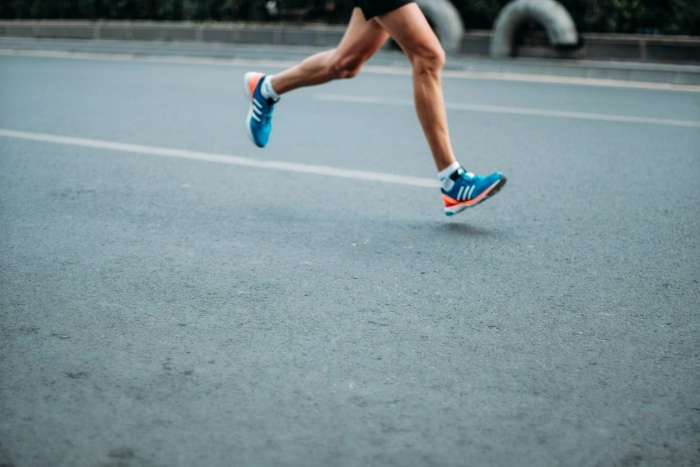Optimizing Running Performance: Guide To Kettlebell Training For Runners

-
Advantages Of Kettlebell Training For Runners
-
Core Stability And Strength Improved.
-
Improved Leg Strength And Power
-
Cardiovascular Endurance, Fatigue Resistance
-
Making Kettlebells Part Of Your Run
-
Functional Exercises With Kettlebells
-
Kettlebell Training For Running Mental Resilience
-
Kettlebell Training Periodization And Progressive Overload
-
Conclusion
Disclosure: Some of the links in this article may be affiliate links, which can provide compensation to me at no cost to you if you decide to purchase. This site is not intended to provide financial advice and is for entertainment only.
Running strains muscles and joints and is a cardiovascular workout. A steady running practice may increase cardiovascular fitness, but runners must also strength train to boost performance and limit injury risk. A dynamic and effective way to attain these aims is kettlebell training.
The form and grip of the kettlebell allow for multi-muscle training. Dynamic kettlebell workouts use stabilizing muscles and build functional strength, unlike weightlifting. This makes them perfect for linear, repeated running. Kettlebell training improves runners' strength, stability, and flexibility, improving efficiency and resilience.
Advantages Of Kettlebell Training For Runners
Core Stability And Strength Improved.
Core strength and stability are critical advantages of kettlebell training for runners. Proper running technique and injury prevention need a strong core. Turkish get-ups and windmills activate the core muscles throughout the activity, providing stability. This improves posture and running mechanics.
Improved Leg Strength And Power
Running focuses on the lower body, but other muscular groups may be overlooked. Kettlebell swings and goblet squats strengthen the hamstrings, glutes, and quads. Balanced strength improves running performance and joint stability, preventing overuse problems.
Cardiovascular Endurance, Fatigue Resistance
Strength and cardiovascular endurance may be achieved with kettlebell training. High-intensity kettlebell circuits or interval training raises the heart rate, similar to running. This dual-focus method improves aerobic capacity and prepares runners for long runs' mental and physical obstacles. Improved fatigue resistance may boost long-distance racing performance.
Making Kettlebells Part Of Your Run
Kettlebell training for runners must be planned to optimize advantages and minimize overtraining. A well-rounded strategy combines strength and dynamic workouts. Start with kettlebell swings and goblet squats before adding snatches and cleans.
A recommended plan includes two to three weekly kettlebell workouts, targeting various muscle areas daily. Listen to your body and alter intensity and volume depending on your running schedule and fitness level. Mobility exercises and warm-up and cool-down routines are essential to avoid injuries and provide a complete fitness program.
Kettlebells enhance runners' workouts. By improving core strength, leg power, and cardiovascular endurance, runners may improve performance and minimize injury risk. A fitness expert may customize a kettlebell workout to meet individual requirements and objectives. Consistency and steady growth are crucial.
Functional Exercises With Kettlebells
Functional motions make kettlebell training ideal for runners. Functional motions include numerous muscle groups and replicate real-life activity. The kettlebell snatch and Turkish get-up need synchronized motions that match the running's dynamic character. These workouts boost strength, proprioception, and coordination.
Functional motions help runners avoid injuries. Kettlebell workouts are multidirectional and test the body differently than weightlifting. Diversity strengthens stabilizing muscles, tendons, and ligaments, decreasing runner imbalances and overuse issues. Functional movements in kettlebell workouts guarantee a complete strength training program that improves running performance.
Runners benefit from lateral and rotational stability exercises. The lateral lunge and Russian twists are kettlebell workouts that target lateral stability and rotational strength, addressing possible weak places running may miss. Runners better handle training and racing by building a balanced strength profile.
Kettlebell Training For Running Mental Resilience
Kettlebell exercise boosts mental resilience, crucial for runners enduring long-distance races and intensive training. Kettlebell movements are purposeful and require attentiveness. Running exercises like the kettlebell clean and press require precise form and control, building a mind-body connection.
Variability and unpredictability are added by kettlebell training. Kettlebells engage the neuromuscular system more than typical weightlifting equipment because they need active stability. This increased obstacle boosts coordination and mental attention. In the running, mental resilience from kettlebell exercise may help sustain concentration for long durations.
Mindfulness activities like breathing and being present in kettlebell training boost mental advantages. Kettlebell exercise builds mental resilience to help runners overcome exhaustion and self-doubt, improving performance and outlook.
Kettlebell Training Periodization And Progressive Overload
Runners need deliberate periodization and progressive loading to optimize kettlebell training effects. Periodization divides a training program into stages with different goals and intensities. Periodization in kettlebell training helps runners avoid plateau fatigue and enhance outcomes.
A good periodized kettlebell program for runners may concentrate on hypertrophy, strength, power, and endurance. Kettlebell goblet squats and higher-rep lunges may boost muscular development during hypertrophy. The strength phase may emphasize complex activities like the kettlebell deadlift with larger weights and lower reps. Kettlebell swings and other explosive workouts may target fast-twitch muscle fibers during power phases.
Another critical factor is progressive overload, which gradually increases training stimuli. This may entail lifting more weight, repeating workouts, or adding complexity. Kettlebell exercise should complement running for runners, not distract them. Runners may improve performance by coordinating kettlebell training with their running season.
Conclusion
Kettlebell training improves running performance in several ways. Kettlebell workouts enhance running by improving mental resilience, functional motions, and strategic periodization. This dynamic training strategy improves strength, stability, endurance, and mentality, helping runners succeed.
-
Advantages Of Kettlebell Training For Runners
-
Core Stability And Strength Improved.
-
Improved Leg Strength And Power
-
Cardiovascular Endurance, Fatigue Resistance
-
Making Kettlebells Part Of Your Run
-
Functional Exercises With Kettlebells
-
Kettlebell Training For Running Mental Resilience
-
Kettlebell Training Periodization And Progressive Overload
-
Conclusion
Disclosure: Some of the links in this article may be affiliate links, which can provide compensation to me at no cost to you if you decide to purchase. This site is not intended to provide financial advice and is for entertainment only.

